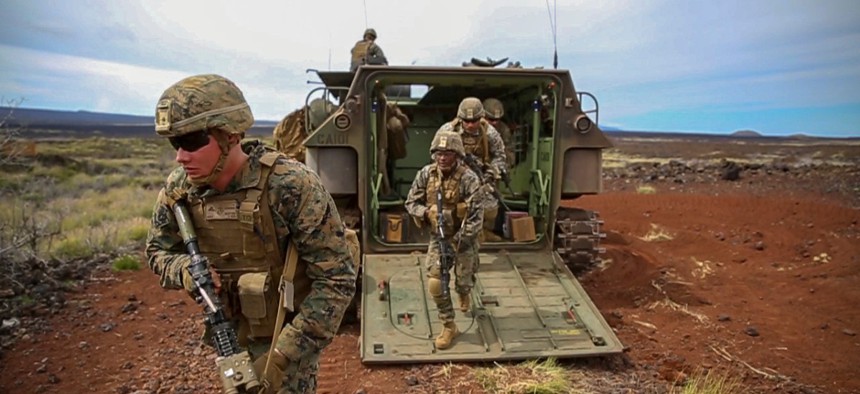Artificial Intelligence Will Still Need Training in the Field, Deputy Defense CIO Says

Marines exit an amphibious assault vehicle during a platoon attack as part of exercise Bougainville II on October. Eric Tso/Marine Corps
The Office of the CIO and Joint AI Center are focused on getting AI deployed throughout the military, which will require some significant culture change.
If the Defense Department is going to build and deploy artificial intelligence, service members from top brass to the battlefield will need to get comfortable using tools that have yet to prove capable, according to a Pentagon IT official.
Today, the U.S. military doesn’t deploy any capabilities without first putting them through rigorous testing and evaluation. That will need to change if the department hopes to harness AI, according to Peter Ranks, Pentagon deputy CIO for information enterprise.
“AI algorithms often go into the field when they are less than 50% effective; when they still have a significant amount of training where they have to encounter real users and real data in order to make them better,” Ranks said during a keynote at the Professional Services Council’s 2019 Vision conference. “That is out of sync with the way we deploy weapons systems in the DOD.”
Ranks noted that most of the work being done within the Defense Department today is still focused on research and development. While outfits like the Defense Advanced Research Projects Agency and the Defense Innovation Unit work on cutting-edge development, Ranks said his office is focused on deploying capabilities at the Pentagon and on the battlefield.
“Although we do need to solve fundamental computer science problems with respect to AI, we also have to solve some very real and immediate cultural problems about the fielding of AI,” he said. He pointed to the need for AI systems to gather training data in live environments as an example.
“We don’t send weapons systems to the field at 50% effectiveness and then hope to iterate over time. We have a very rigorous process before they get cleared,” Ranks said. “That does not work for AI. You cannot wait for your AI to be perfect on practice data before it’s going to go out and meet the enemy. It needs to be deployed and it needs to iterate quickly.”
Part of the CIO Office’s job is to help guide that culture change, as well as ensuring work isn’t being duplicated across the department. To accomplish these tasks, the department created the Joint Artificial Intelligence Center, or JAIC, “to bring some order to the chaos,” Ranks said.
One of the JAIC’s key roles is establishing a “common foundation,” which Ranks described as a “set of tools and capabilities, as well as methodology that we don’t believe every program that wants to work in AI should have to reinvent.”
Eventually, that common foundation will manifest in an “exportable set of capabilities” that can be used across the department to meet specific mission requirements using AI.
“The algorithms might be unique. The AI problems might be unique. But the toolsets, the DevSecOps foundation, some of the data ingestion—none of that stuff needs to be recreated each time,” Ranks said.



